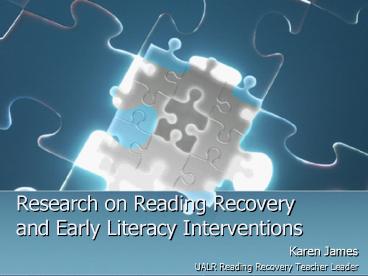Research on Reading Recovery and Early Literacy Interventions - PowerPoint PPT Presentation
1 / 24
Title:
Research on Reading Recovery and Early Literacy Interventions
Description:
Dorn & Allen (1999) Harrison (2002) Iverson (1997) Schwartz (2005) Rodgers, et al (2004) ... Elbaum (2000) Iverson (1997) Tunmer & Chapman (2003) Thinking about ... – PowerPoint PPT presentation
Number of Views:203
Avg rating:3.0/5.0
Title: Research on Reading Recovery and Early Literacy Interventions
1
Research on Reading Recovery and Early Literacy
Interventions
- Karen James
- UALR Reading Recovery Teacher Leader
2
Current UALR Research
- 14,121 first grade students
- 6 states
- Arkansas Alaska
- Missouri Tennessee
- Oklahoma Louisiana
- Students taught by Reading Recovery teachers
3
Purpose of the Study
- Determine the most effective early interventions
for first grade students in a comprehensive
intervention model.
4
Current Study
- Schwartz (2005)
- Rodgers, et al (2004)
- Tunmer Chapman (2003)
- Vaughn, et al (2003)
- In the same field as many often-cited studies
- Pinnell (1991,1994)
- Elbaum Vaughn (2000)
- Dorn Allen (1999)
- Harrison (2002)
- Iverson (1997)
5
Methodology
- Gain scores were computed using a pre-post
analysis on the mean - Significance was computed using a paired-samples
t-test
6
Research Question
- What was the end of year progress of overall
achievement for students served in Reading
Recovery only as compared to Small Group Literacy
only?
7
Initial Finding
- Students served in Reading Recovery only had a
mean gain of 16.33 text levels (n2977) - Students served in Small Group only had a mean
gain of 16.24 text levels (n3586)
8
Interpretation
- Statistically, there is no performance difference
between the groups of students. - This finding is consistent with findings in the
following studies - Vaughn (2003) Foorman (1988)
- Elbaum (2000) Iverson (1997)
- Tunmer Chapman (2003)
9
Thinking about this finding
- Students who needed RR only they are doing well
- Students who needed small group only they are
doing well - This finding really isnt striking
10
Root Cause Analysis
- Looking beyond the surface
- How many students who were served in small group
needed Reading Recovery later in the year? - Was there a change in learning trajectory for
these students after entering Reading Recovery?
11
Further Analysis
- 6143 students were served in small group
- Of these, 2423 students required Reading Recovery
later in the year - 39.4 of students who entered small group, needed
Reading Recovery later in the year.
12
Performance in Group only
Growth between Fall and Exit text reading means
are statistically significant (.95 level)
13
Implication
- Students served in groups are making progress
(statistically significant) - But, will it be enough? What is their projected
outcome based on prior performance?
14
Performance in Group Trajectory
15
Finding and Implication
- Students served in group only will continue to
make some progress under current trajectory - Projected growth will not enable students to meet
grade level expectations by the end of the year
16
Further Analysis
- Does the participation in Reading Recovery
following small group change the learning
trajectory for students?
17
Group Reading Recovery
Growth between Fall Entry Entry End of
Program are statistically significant (.95 level)
18
Consolidation of Findings
The difference between Actual End of Program text
reading and the Group trajectory are
statistically significant (.95 level)
19
The Reality of the Findings
- Students were moved to higher reading groups
within the classroom as their reading improved.
20
Additional findings Classroom Reading Group
21
Classroom Reading Groups Entry into Reading
Recovery
22
Classroom Reading GroupsEnd of Reading Recovery
23
Implications
- Reading Recovery is successful and provides a
cornerstone for interventions. - Small groups are successful, and are the
intervention of choice for the less needy
students. - Meeting the needs of our most needy requires
multi-layered solutions.
24
Recommendations for Future Research
- Continue current study with 2005-2006 students
- Randomized trial study 2006-2007
- Effectiveness of Reading Recovery Push-in
interventions - Effectiveness of Reading Recovery Special
Education interventions































